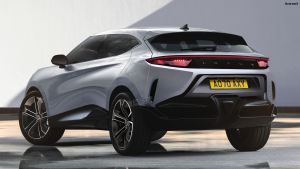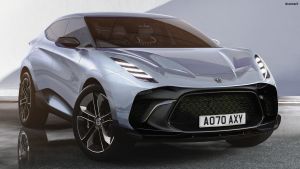J
John McIlroy
Guest
Lotus has revealed a substantial new product strategy that will see the company move beyond sports car manufacturing and likely into SUVs, using four platforms to create a Lotus line-up broader than at any other point in the marque’s history.
The arrival of the all-new combustion powered Emira sports car, which will be revealed this summer, will usher in the second of four planned architectures. These will all support Lotus’s expansion as the company heads towards its 80th birthday in 2028, under the stewardship of new boss Matt Windle.
The first platform, called Hypercar, has already been seen supporting the 2,000bhp Evija, production of which is scheduled to begin later this year. The new Emira will sit on a platform called Elemental by Lotus staff, but labelled ‘Sports car architecture’ in all external communications about the new strategy.
This new sports car platform uses Lotus’s renowned extruded aluminium technology, but the firm describes the chassis as “a massive step-change technically”.
The two remaining new platforms will support not only Lotus’s widened model range, but also the aspirations of the Lotus Engineering consultancy business, which has the goal of selling and licensing the tech to other manufacturers. Indeed, while Lotus will use some common components from its parent group Geely, all four of its platforms will remain exclusive to it within the group - giving Lotus Engineering greater freedom to pitch them to external rivals.
Lotus is calling one of these new platforms its Premium architecture, which is the company’s “first ever truly global automotive architecture”. After years of speculation, and armed with this new platform, Lotus is now speaking openly about using it for “an all-new range of lifestyle vehicles” - expected to be SUVs - that will “catapult Lotus into a new era of higher retail volumes and significant revenues”.
Our exclusive images show how an all-electric Lotus SUV could look, using a new design language the firm will interpret from the Evija hypercar and the upcoming Emira sports car.

Lotus SUV - rear (watermarked)

Lotus SUV - front (watermarked)
Speaking with Auto Express, Lotus chief designer Russell Carr says that the lifestyle models will still be identifiable as Lotus vehicles.
“When we review all the vehicles we always put them in context of what the opposition is doing,” he said. “And when you do look at them in that context, because of proportions, stance and surface treatment, to my eyes they look instantly more agile, and more sporty vehicles than the obvious competition.”
The fourth and final platform is the Electric Sports Car Architecture - known internally as E-Sports. It’s scalable but is likely to be launched with a smaller electric sports car model - not least because this platform will also be used for the successor to the current Alpine A110.
Lotus is expected to publish a more detailed product roadmap later in the year, but new boss Windle did confirm that all four of the architectures will be in use by 2028. “When you consider that two will already be in use by the end of 2021, it’s a head start,” he stated.
All of Lotus’s new sports cars will be built at the firm’s Norfolk base. But the lifestyle models on the Premium platform will be manufactured at a new plant in China - almost certainly alongside other Geely Auto group vehicles.
Significant investment is already transforming Lotus’s HQ at Hethel, though, with a state-of-the-art paint shop under construction and a new automated production line already installed. It will be capable of producing 5,000 Emiras per year on a single shift - treble the total number across Elise, Exige and Evora that the facility has been making until recently.

Former engineering boss Matt Windle has been in the big chair at Lotus since January. He has extensive experience at the firm, although he also had a six-year spell working at Tesla.
Q: You’re launching four platforms, so how many models can these support for Lotus?
A: “The whole aim of the strategy is to give us the scale, give us the range of vehicles. The opportunity is there to go from a lightweight sports car, Emira, up to the lifestyle vehicles we’re talking about, and everything in between, really.”
Q: What should we expect from Emira – core Lotus values or is it targeting broader appeal?
A: “I think people will be quite surprised by the car. We’re comfortable with ourselves; we’ve found the right design language, and we’re working on products that have simplification, but also the technology people would expect.
“We’ve spent a lot of time on usability, too – making sure the interior has somewhere for your phone, your water bottle, your coffee cup. It really is a new Lotus through and through.”
Q: What’s it like managing Lotus through this period, with old models ending and new ones coming, but not on sale just yet?
A: “For everyone, really, it’s like two jobs in one. Day to day you have the cash and the cars you’ve got to get out, but then you get a request to sign off a couple of million pounds for tooling! It’s like a parallel activity – but it’s good. There’s such a difference in the whole atmosphere here.”
Are you excited about the prospect of a Lotus SUV? Let us know your thoughts below...
Continue reading...
The arrival of the all-new combustion powered Emira sports car, which will be revealed this summer, will usher in the second of four planned architectures. These will all support Lotus’s expansion as the company heads towards its 80th birthday in 2028, under the stewardship of new boss Matt Windle.
The first platform, called Hypercar, has already been seen supporting the 2,000bhp Evija, production of which is scheduled to begin later this year. The new Emira will sit on a platform called Elemental by Lotus staff, but labelled ‘Sports car architecture’ in all external communications about the new strategy.
This new sports car platform uses Lotus’s renowned extruded aluminium technology, but the firm describes the chassis as “a massive step-change technically”.
The two remaining new platforms will support not only Lotus’s widened model range, but also the aspirations of the Lotus Engineering consultancy business, which has the goal of selling and licensing the tech to other manufacturers. Indeed, while Lotus will use some common components from its parent group Geely, all four of its platforms will remain exclusive to it within the group - giving Lotus Engineering greater freedom to pitch them to external rivals.
Lotus is calling one of these new platforms its Premium architecture, which is the company’s “first ever truly global automotive architecture”. After years of speculation, and armed with this new platform, Lotus is now speaking openly about using it for “an all-new range of lifestyle vehicles” - expected to be SUVs - that will “catapult Lotus into a new era of higher retail volumes and significant revenues”.
Our exclusive images show how an all-electric Lotus SUV could look, using a new design language the firm will interpret from the Evija hypercar and the upcoming Emira sports car.

Lotus SUV - rear (watermarked)

Lotus SUV - front (watermarked)
Speaking with Auto Express, Lotus chief designer Russell Carr says that the lifestyle models will still be identifiable as Lotus vehicles.
“When we review all the vehicles we always put them in context of what the opposition is doing,” he said. “And when you do look at them in that context, because of proportions, stance and surface treatment, to my eyes they look instantly more agile, and more sporty vehicles than the obvious competition.”
The fourth and final platform is the Electric Sports Car Architecture - known internally as E-Sports. It’s scalable but is likely to be launched with a smaller electric sports car model - not least because this platform will also be used for the successor to the current Alpine A110.
Lotus is expected to publish a more detailed product roadmap later in the year, but new boss Windle did confirm that all four of the architectures will be in use by 2028. “When you consider that two will already be in use by the end of 2021, it’s a head start,” he stated.
All of Lotus’s new sports cars will be built at the firm’s Norfolk base. But the lifestyle models on the Premium platform will be manufactured at a new plant in China - almost certainly alongside other Geely Auto group vehicles.
Significant investment is already transforming Lotus’s HQ at Hethel, though, with a state-of-the-art paint shop under construction and a new automated production line already installed. It will be capable of producing 5,000 Emiras per year on a single shift - treble the total number across Elise, Exige and Evora that the facility has been making until recently.
Q&A - Matt Windle, managing director, Group Lotus

Former engineering boss Matt Windle has been in the big chair at Lotus since January. He has extensive experience at the firm, although he also had a six-year spell working at Tesla.
Q: You’re launching four platforms, so how many models can these support for Lotus?
A: “The whole aim of the strategy is to give us the scale, give us the range of vehicles. The opportunity is there to go from a lightweight sports car, Emira, up to the lifestyle vehicles we’re talking about, and everything in between, really.”
Q: What should we expect from Emira – core Lotus values or is it targeting broader appeal?
A: “I think people will be quite surprised by the car. We’re comfortable with ourselves; we’ve found the right design language, and we’re working on products that have simplification, but also the technology people would expect.
“We’ve spent a lot of time on usability, too – making sure the interior has somewhere for your phone, your water bottle, your coffee cup. It really is a new Lotus through and through.”
Q: What’s it like managing Lotus through this period, with old models ending and new ones coming, but not on sale just yet?
A: “For everyone, really, it’s like two jobs in one. Day to day you have the cash and the cars you’ve got to get out, but then you get a request to sign off a couple of million pounds for tooling! It’s like a parallel activity – but it’s good. There’s such a difference in the whole atmosphere here.”
Are you excited about the prospect of a Lotus SUV? Let us know your thoughts below...
Continue reading...
